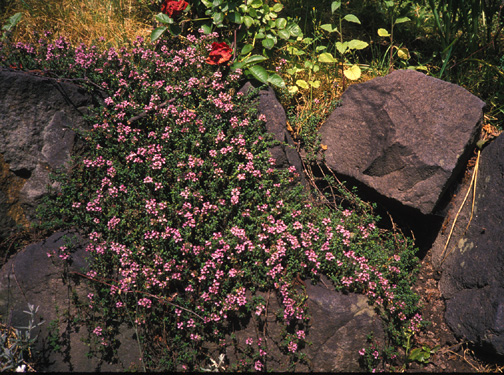
|
| Caraway Thyme; Thymus Herba-barona Loisel. |
Mint Family; LABIATÆ
|
| Could the scent of Caraway Thyme be imparted to this paper as easily as its appearance, words would be unnecessary to convince you to grow it. Its delightful fragrance alone would spark desire. But since the newsletter cannot carry scent, the only option is to write convincingly, hoping thereby that words from the heart will stimulate you to feel, smell, taste, and grow this wonderfully perfumed plant of great worth and too little familiarity. |
| Caraway Thyme is a sprawling groundcover herb, an informal loose mat several inches high. Native to the Mediterranean islands of Corsica and Sardinia, it is an evergreen species of dry, rocky soils, and cannot receive too much sunshine. The leaves are rich, dark, and shining, a quarter of an inch long, borne on arching reddish stems, slender and delicate, rooting at the tips. |
| Bright deep rosy pink flowers appear in June and July, and are as pleasing to behold as the odor is to smell. Bees much relish the blossoms, humming softly as they make their rounds in search of nectar. |
| Hundreds of years ago Caraway Thyme was imported from its native islands into continental Europe to use as a seasoning for beef: the baron of beef primarily, hence the specific name Herba-barona. It's also been known as Seedcake Thyme, and a practically identical plant is called Nutmeg Thyme. |
| I grow a dozen thymes, but Caraway is the pet of them all. It is not the prettiest, nor the most vigorous, nor best to eat, but it is favored because its candy-like, refreshing fragrance is a never-ceasing joy. Blooming roses in June are precious and heady when smelled; fresh strawberries make mouths water eagerly, but both are seasonal treats only, while thyme and its fragrance are forever. The day may be pouring rain, or the ground frosty, but Caraway Thyme still yields its gratifying essence. |
| Plant it in a sunny place by a sidewalk or path, so anyone who brushes against it or treads upon it will release its fragrance. Water it sparingly or not at all, once it is established. The best soil for it is sandy or gravelly and well-drained. The plant can get by just fine without human help, but if fallen leaves, weeds, or other plants shade it, then come to the rescue. You'll never regret it. |
It is a perfect gift. Easily acquired either by buying or self-propagating, it will quickly root and always be there when you need to pot-up a bit. Since it looks good all year and smells like a love potion, you can give starts to anyone, and gleefully watch as the recipient's puzzled face relaxes into a surprise smile when the warm aroma is detected.
|
(Originally published in the December 1989 Seattle Tilth newsletter, along with an illustration.)
Back |
|
|

